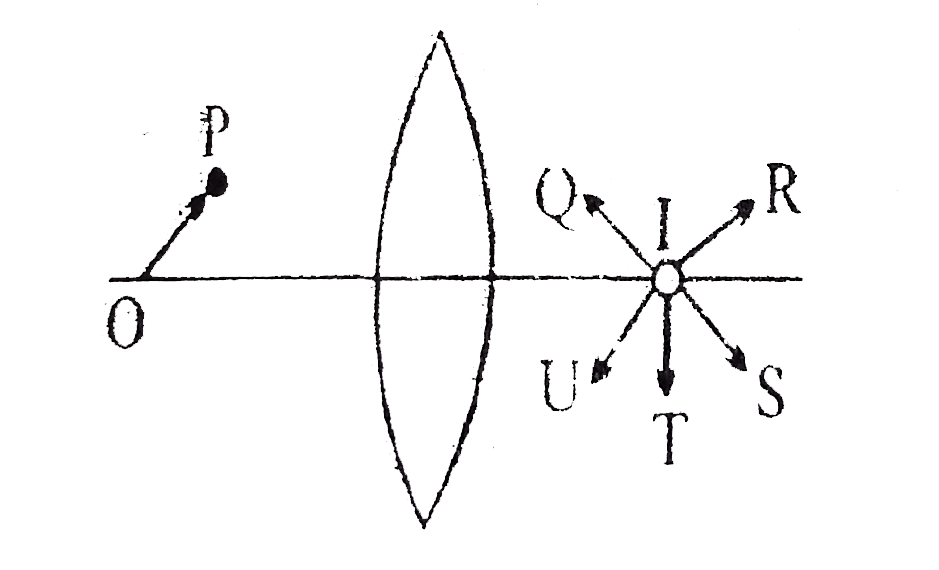A point object moves along the principal axis of a convex lens of focal length f such that its real image, also formed on the principal axis at a distance 4f3 (at t=0) moves away from the lens with uniform velocity α. Find the velocity of the point object as a function of time t.
(ff+αt)2α
(αf+αt)2
(f/3+αt2f)2α
⎛⎜⎝ff3+αt⎞⎟⎠2α
The correct Answer is:D
To solve the problem step by step, we will use the lens formula and the relationship between the object and image distances.
Step 1: Understand the initial conditions
At time t=0, the image is formed at a distance v=4f3 from the lens. We need to find the object distance u at this time.
Step 2: Apply the lens formula
The lens formula is given by:
1f=1v−1u
Substituting the known values:
1f=14f3−1u
This simplifies to:
1f=34f−1u
Step 3: Rearranging to find u
Rearranging gives:
1u=34f−1f
Finding a common denominator:
1u=3−44f=−14f
Thus, we find:
u=−4f
The negative sign indicates that the object is on the same side as the incoming light (the left side of the lens).
Step 4: Determine the image position at time t
At time t, the image moves away from the lens with a uniform velocity α. Therefore, the position of the image at time t is:
v(t)=4f3+αt
Step 5: Apply the lens formula again at time t
Using the lens formula again with the new image position:
1f=1v(t)−1u(t)
Substituting for v(t):
1f=1(4f3+αt)−1u(t)
Step 6: Rearranging to find u(t)
Rearranging gives:
1u(t)=1(4f3+αt)−1f
Finding a common denominator:
1u(t)=f−(4f3+αt)f(4f3+αt)
This simplifies to:
1u(t)=f−4f3−αtf(4f3+αt)=−f3−αtf(4f3+αt)
Thus:
u(t)=f(4f3+αt)−f/3−αt
Step 7: Find the velocity of the object
The velocity vo of the object is given by the change in position over time:
vo=u(t)−u(0)t
Substituting u(0)=−4f:
vo=u(t)+4ft
Substituting u(t) from the previous step:
vo=f(4f3+αt)−f/3−αt+4ft
After simplifying, we find:
vo=3fαtf(t3+αt2)
Final Result
The velocity of the point object as a function of time t is:
vo=3fαtf(t3+αt2)
At time t=0, the image is formed at a distance v=4f3 from the lens. We need to find the object distance u at this time.
The lens formula is given by:
1f=1v−1u
Substituting the known values:
1f=14f3−1u
This simplifies to:
1f=34f−1u
Rearranging gives:
1u=34f−1f
Finding a common denominator:
1u=3−44f=−14f
Thus, we find:
u=−4f
The negative sign indicates that the object is on the same side as the incoming light (the left side of the lens).
At time t, the image moves away from the lens with a uniform velocity α. Therefore, the position of the image at time t is:
v(t)=4f3+αt
Using the lens formula again with the new image position:
1f=1v(t)−1u(t)
Substituting for v(t):
1f=1(4f3+αt)−1u(t)
Rearranging gives:
1u(t)=1(4f3+αt)−1f
Finding a common denominator:
1u(t)=f−(4f3+αt)f(4f3+αt)
This simplifies to:
1u(t)=f−4f3−αtf(4f3+αt)=−f3−αtf(4f3+αt)
Thus:
u(t)=f(4f3+αt)−f/3−αt
The velocity vo of the object is given by the change in position over time:
vo=u(t)−u(0)t
Substituting u(0)=−4f:
vo=u(t)+4ft
Substituting u(t) from the previous step:
vo=f(4f3+αt)−f/3−αt+4ft
After simplifying, we find:
vo=3fαtf(t3+αt2)
The velocity of the point object as a function of time t is:
vo=3fαtf(t3+αt2)
Topper's Solved these Questions
- GEOMETRICAL OPTICSBOOK - AAKASH SERIESCHAPTER - GEOMETRICAL OPTICSEXERCISE - ADDITIONAL PRACTICE EXERCISE -I (LEVEL-II LECTURE SHEET (ADVANCED) MORE THAN ONE CORRECT TYPE QUESTIONS)
3 Videos
- GEOMETRICAL OPTICSBOOK - AAKASH SERIESCHAPTER - GEOMETRICAL OPTICSEXERCISE - ADDITIONAL PRACTICE EXERCISE -I (LEVEL-II LECTURE SHEET (ADVANCED) LINKED COMPREHENSION TYPE QUESTIONS)
8 Videos
- GEOMETRICAL OPTICSBOOK - AAKASH SERIESCHAPTER - GEOMETRICAL OPTICSEXERCISE - ADDITIONAL PRACTICE EXERCISE -I (LEVEL-I(MAIN) STRAIGHT OBJECTIVE TYPE QUESTIONS)
21 Videos
- ELEMENTS OF VECTORSBOOK - AAKASH SERIESCHAPTER - ELEMENTS OF VECTORSEXERCISE - QUESTIONS FOR DESCRIPTIVE ANSWERS
10 Videos
- LAWS OF MOTIONBOOK - AAKASH SERIESCHAPTER - LAWS OF MOTIONEXERCISE - PRACTICE EXERCISE
106 Videos
Similar Questions
An object of length 2.0 cm is placed perpendicular to the principal axis of a convex lens of focal length 12 cm. Find the size of the image of the object is at a distance of 8.0 cm from the lens.
View SolutionA point object O moves from the principal axis of a converging lens in a direction OP. I is the image of O, will move initially in the direction

View SolutionAn object is placed at a distance of f2 from a convex lens of focal length f. The image will be
View SolutionWhere should an object be kept on the principal axis of a convex lens of focal length 20 cm, in order to get an image, which is double the size of the object?
View SolutionA thin linear object of size 1mm is kept along the principal axis of a convex lens of focal length 10cm. The object is at 15cm from the lens. The length of the image is:
View SolutionAn illuminated object is placed on the principal axis of a converging lens so that real image is formed on the other side of the lens. If the object is shifted a little,
View SolutionA convex lens of focal length 30 cm produces 5 times magnified real image of an object. What is the object distance?
View SolutionA point object is moving on the principal axis of a concave mirror of focal length 24cm towards the mirror. When it is at a distance of 60cm from the mirror, its velocity is . 9sec/cm What is the velocity of the image at that instant
View SolutionA convex lens has a focal length of 10 cm. Find the location and nature of the image if a point object is placed on the principal axis at a distance of (a) 9.8 cm, (b) 10.2 cm from the lens.
View SolutionA convex lens of focal length f produces an image 1n times than that of the size of the object. The distance of the object from the lens is:
View Solution
